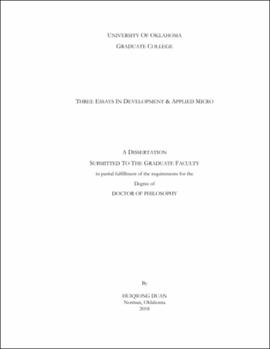| dc.description.abstract | Chapter 1: China’s National Poor Counties (NPCs) program represents one of the largest anti-poverty efforts ever undertaken in a developing country. In spite of this, no causal analysis has been undertaken to examine whether counties which graduate from the program actually achieve sustainable growth after support is removed. This paper provides the first long-term analysis of China’s NPCs program on local development, investigating whether poor regions continue to develop economically after exiting the anti-poverty program. Focusing on the period 1986 to 2010, I construct plausible counterfactuals for counties that participated and graduated from the NPCs registry using the synthetic control method. This exercise reveals several new insights. First, on average, graduates of China’s anti-poverty exhibit roughly the same growth outcomes as those still receiving support from the program. Second, I show that focusing on the average impact masks sizeable heterogeneity when disaggregating to a case by case analysis of counties. Importantly, for the subset of counties which graduated from the first wave of the poverty reduction program in 1993, there is a demonstrably faster expansion post-graduation. For more recent county’s graduating from the program, however, I find significantly negative impacts of NPCs program completion in the long run.
Chapter 2: This paper studies the impact of the 1988/1989 educational reform in Jordan which extended mandatory schooling from nine to ten years and restructured secondary schooling. Despite weakness in the Jordanian labor market, our estimates suggest that an additional year of required schooling in the late 1980s was sufficient to improve labor force participation, employment, and wages. These effects were initially largest for women, while males with more education were also slightly more likely to be self-employed, work longer hours, and earn higher wages. We show that the extensive margin labor market gains we observe for men strengthen with age.
Chapter 3: This paper studies son preference among households in the United States. I present two analyses using the American Community Survey from 2012 to 2016. First, I estimate son preference in aggregate among parents in the U.S., contrasting immigrant populations to that of native born individuals. I consider evidence of two direct mechanisms – fertility stopping decisions and gender selection behavior. I show that there is no evidence of son preference among families in the U.S in aggregate through either mechanism, but there is indirect evidence of son preference -- mothers of daughters are less likely to be married than mothers of sons. Next, I analyze assimilation of immigrant gender preferences to U.S. norms relying on variation in duration of residence in the U.S., age of migration, and generation of migration. I find significant evidence to support the claim of son preference among first-generation immigrant populations originating from Asia and find that those son preferences were formed early in life, and once established, persist among first-generation immigrants. Higher order generations exhibit weaker gender selection, consistent with assimilation to U.S. norms. Assimilation exhibits a high degree of heterogeneity across populations. Second and higher order generation Chinese immigrants conform to U.S. norms, while surprisingly, Indian immigrants exhibit even stronger son preference among higher-order generations. | en_US |
